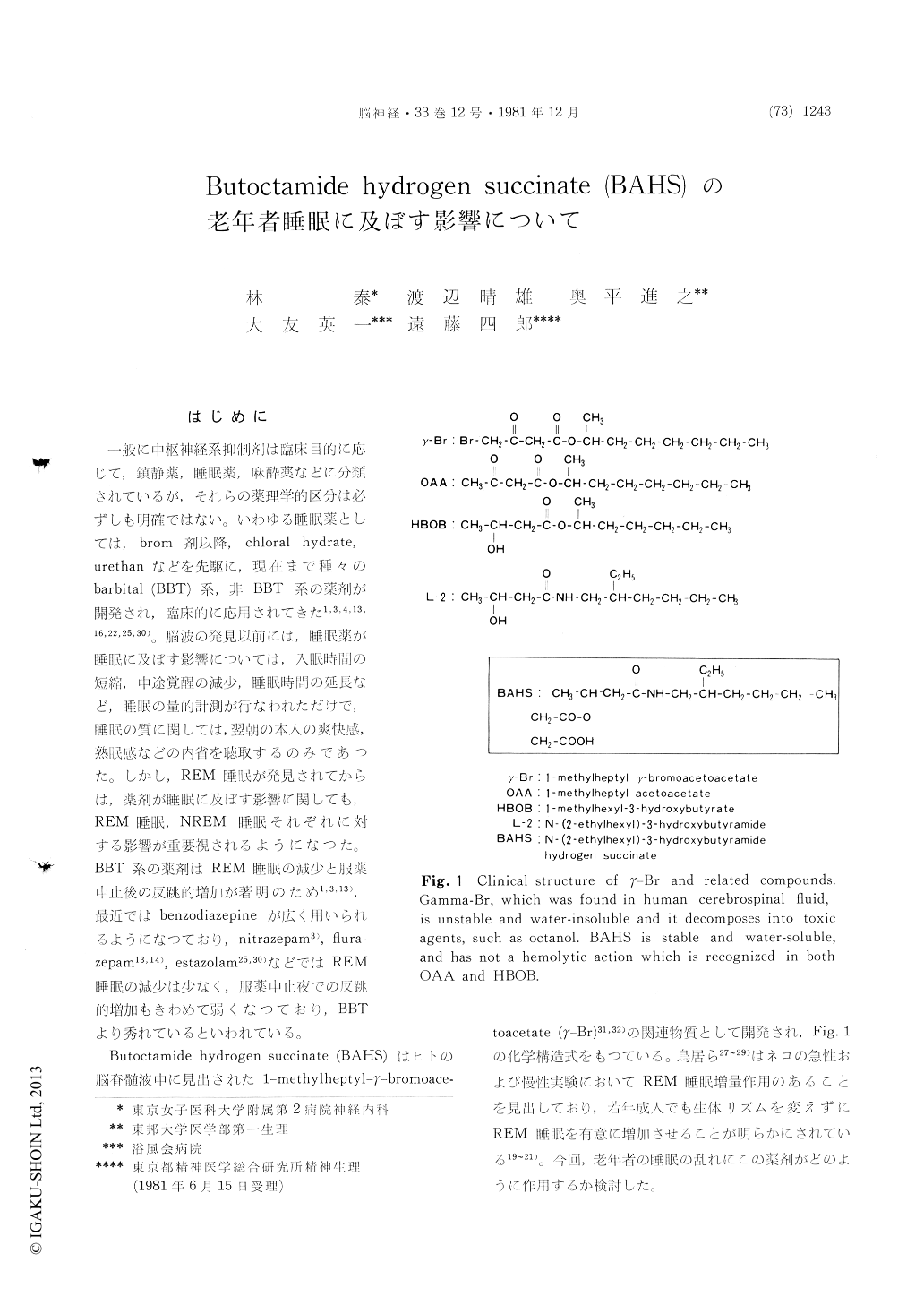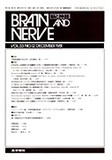Japanese
English
- 有料閲覧
- Abstract 文献概要
- 1ページ目 Look Inside
はじめに
一般に中枢神経系抑制剤は臨床目的に応じて,鎮静薬,睡眠薬,麻酔薬などに分類されているが,それらの薬理学的区分は必ずしも明確ではない。いわゆる睡眠薬としては,brom剤以降,chloral hydrate,urethanなどを先駆に,現在まで種々のbarbital (BBT)系,非BBT系の薬剤が開上発され,臨床的に応用されてきた1,3,4,13,16,22,25,30)。脳波の発見以前には,睡眠薬が睡眠に及ぼす影響については,入眠時間の短縮,中途覚醒の減少,睡眠時間の延長など,睡眠の量的計測が行なわれただけで,睡眠の質に関しては,翌朝の本人の爽快感,熟眠感などの内省を聴取するのみであつた。しかし,REM睡眠が発見されてからは,薬剤が睡眠に及ぼす影響に関しても,REM睡眠,NREM睡眠それぞれに対する影響が重要視されるようになつた。BBT系の薬剤はREM睡眠の減少と服薬中止後の反跳的増加が著明のため1,3,13),最近ではbenzodiazepineが広く用いられるようになつており,nitrazeparn3),flura—zepam13,14),estazolam25,30)などではREM睡眠の減少は少なく,服薬中止夜での反跳的増加もきわめて弱くなつており,BBTより秀れているといわれている。
Butoctamide hydrogen succinate (BAHS)はヒトの脳脊髄液中に見出された1—methylheptyl—γ—bromoace—toacetate (γ—Br)31,32)の関連物質として開発され,Fig.1の化学構造式をもつている。
Butoctamide hydrogen succinate (BAHS), related to an organic bromine compound naturally occur-ring in the cerebrospinal fluid, has been shown to increase REM sleep in cats and young adults. The purpose of this study is to observe the effects of BAHS on the sleep of the aged people. The sub-jects were six aged females, aged between 68 and 77, admitted in the Yokufukai Nursing Home. The experimental schedule covered eight consecutive nights, i. e. three control nights, three drug nights, and two withdrawal nights. Identical capsules con-taining either a placebo (linolenic acid) or BAHS (600 mg) were administered at 20:00h. Polysom-nograms were recorded from 21:00 till 06:00h.
The average time of sleep onset latency for the control nights was 36.6±46.9 minutes and 31.9±24.3 minutes for the drug nights; the number of awakenings was 18.0±9.2 and 14.8±5.9; and the number of stage shifts was 100.4±36.5 and 88.6±28.1, respectively. Those results supported the report that BAHS had the effects as a minor tranquilizer.
The average percentage of SW was 21.8±13.6 for the control nights and 16.5±6.5 for the drug nights; S1 was 14.8±4.4 and 14.8±4.6; S2 was 47.4±11.5 and 50.3±6.1; S3 was 4.0±4.3 and 3.0±3.0; S4 was 0.2±0.5 and 0.2±0.5; and SREM was 11.8±4.4 and 15.3±2.9, respectively. There was a significant difference in the percentage of SREM between the control nights and the drug nights (P<0.02). The average number of REM periods was 3.1±0.7 for the control nights and 3.7±0.8 for the drug nights, with statistically significant difference (P<0.05). The duration of the first four REM sleep in intrasleep cycle were 18.3±10.9, 17.0±9.7, 14.3±7.3 and 18.3±1.5 minutes for the control nights, and 18.9±6.7, 18.8±7.8, 22.6±9.9 and 16.7±8.9 minutes for the drug nights. The third REM period was sig-nilicantly prolonged in the drug nights (P<0.05). The interruptions of REM sleep were decreased in the number for the drug nights compared with those of the control nights. The study of the histogram of REM sleep suggested that REM sleep was increased in the latter part of the night with apparent two peaks in the drug nights compared with that in the control nights. REM density was decreased in the drug nights compared with that in the control nights.
The mechanism which increases REM sleep is suggested that BAHS increases the amount of serotonin in the brain, and secondary, serotonin increases REM sleep.
In summary, BAHS seems to be a unique hyp-notic drug which increases REM sleep, while other clinically used hypnotic drugs suppress it.

Copyright © 1981, Igaku-Shoin Ltd. All rights reserved.


